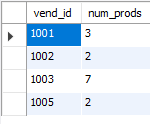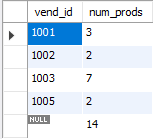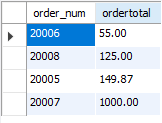1、数据分组
1 #连接数据库 2 use newschema; 3 #查看表中数据 4 select *from products; 5 #返回供应商1003提供的产品数目 6 select count(*) as num_prods from products where vend_id=1003;

2、创建分组
select vend_id,count(*) as num_prods from products group by vend_id;

**Group By 子句必须出现在where自居之后,order by 子句之前。
#使用with rollup select vend_id,count(*) as num_prods from products group by vend_id with rollup; #使用with rollup关键字,可以得到每个分组以及每个分组汇总级别(针对每个分组)的值。

3、过滤分组
所有类型的where子句都可以用having来替代。唯一差别师where过滤行,而having过滤分组。
select cust_id,count(*) as orders from orders group by cust_id having count(*)>=2;

having和where的差别:where在数据分组前进行过滤,having在数据分组后进行过滤。
select vend_id,count(*) as num_prods from products where prod_price>=10 group by vend_id having count(*)>=2;

分析:where子句过滤所有prod_price至少为10 的行,然后按照cend_id 分组,having子句过滤计数为2或2以上的分组。
select vend_id,count(*) as num_prods from products group by vend_id having count(*)>=2;

4、分组和排序
select order_num,sum(quantity*item_price) as ordertotal from orderitems group by order_num having sum(quantity*item_price)>=50;

select order_num,sum(quantity*item_price) as ordertotal from orderitems group by order_num having sum(quantity*item_price)>=50 order by ordertotal;

5、select子句顺序
下列表是在使用select语句时必须遵循的次序
| select |
| from |
| where |
| group by |
| having |
| order by |
| limit |